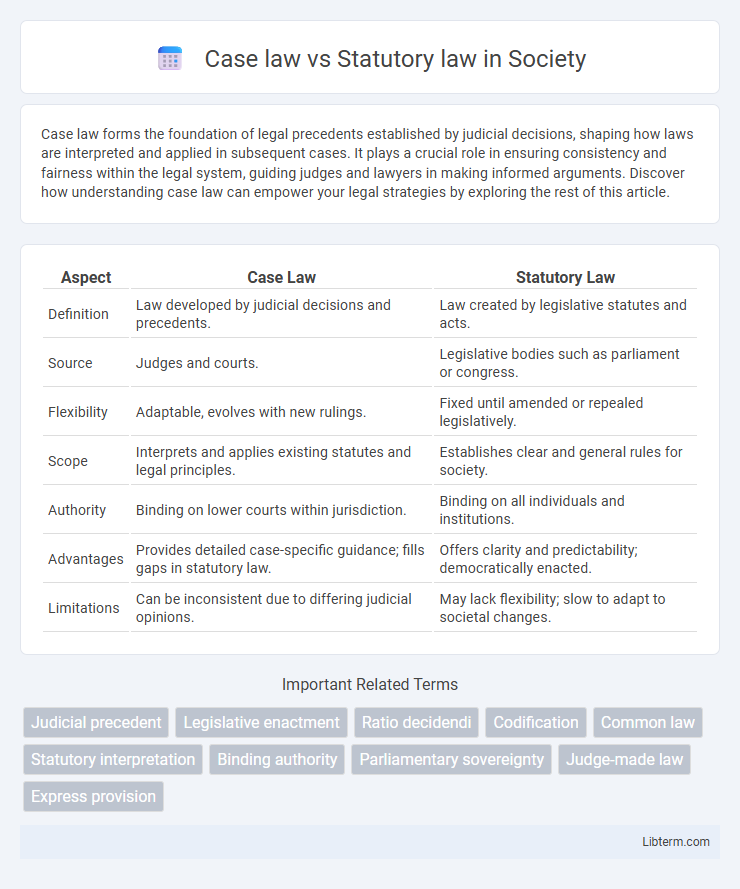Case law forms the foundation of legal precedents established by judicial decisions, shaping how laws are interpreted and applied in subsequent cases. It plays a crucial role in ensuring consistency and fairness within the legal system, guiding judges and lawyers in making informed arguments. Discover how understanding case law can empower your legal strategies by exploring the rest of this article.
Table of Comparison
| Aspect | Case Law | Statutory Law |
|---|---|---|
| Definition | Law developed by judicial decisions and precedents. | Law created by legislative statutes and acts. |
| Source | Judges and courts. | Legislative bodies such as parliament or congress. |
| Flexibility | Adaptable, evolves with new rulings. | Fixed until amended or repealed legislatively. |
| Scope | Interprets and applies existing statutes and legal principles. | Establishes clear and general rules for society. |
| Authority | Binding on lower courts within jurisdiction. | Binding on all individuals and institutions. |
| Advantages | Provides detailed case-specific guidance; fills gaps in statutory law. | Offers clarity and predictability; democratically enacted. |
| Limitations | Can be inconsistent due to differing judicial opinions. | May lack flexibility; slow to adapt to societal changes. |
Introduction to Case Law and Statutory Law
Case law, also known as judicial precedent, consists of legal principles established by court decisions that interpret statutes and regulations, shaping future rulings. Statutory law comprises written laws enacted by legislative bodies, providing clear and codified rules that govern society. Understanding the distinction between case law and statutory law is crucial for applying legal principles accurately across various judicial contexts.
Defining Case Law
Case law, also known as judicial precedent, consists of legal principles and rules established through decisions made by courts in individual cases. It interprets and applies statutory law by examining prior judicial rulings, thus creating a body of consistent legal standards. Courts rely on case law to resolve disputes when statutes are ambiguous or silent on specific issues.
Defining Statutory Law
Statutory law encompasses laws formally enacted by legislative bodies, such as Congress or state legislatures, providing clear, codified legal standards. These laws are written statutes that establish specific rights, duties, and regulations, contrasting with case law, which derives from judicial decisions and precedents. Statutory law serves as the foundation for legal interpretation and enforcement, offering explicit legal frameworks that guide courts and agencies.
Origins and Sources of Case Law
Case law originates from judicial decisions made by courts, serving as a source of law through the principle of precedent, where past rulings guide future cases. Its foundation lies in common law systems, primarily developed in England, contrasting with statutory law, which is created by legislative bodies through formal statutes. The authority of case law depends on its interpretation and application of existing statutes, legal principles, and constitutional provisions.
Origins and Sources of Statutory Law
Statutory law originates from legislatures and is codified in statutes and ordinances enacted by government bodies, reflecting formal written legal rules. These laws derive authority from constitutions, which empower legislatures to create binding regulations on society. Unlike case law, which evolves through judicial decisions, statutory law provides clear, predetermined standards that govern conduct and resolve disputes.
The Role of Judicial Precedent
Judicial precedent plays a crucial role in case law by ensuring consistency and predictability in legal decisions through the principle of stare decisis, where courts follow prior rulings on similar issues. Statutory law, derived from legislative statutes, provides the foundational legal framework, while case law interprets and applies these statutes to specific situations, filling gaps and resolving ambiguities. The interaction between judicial precedent and statutory law enhances the development of a coherent and adaptable legal system.
Interpretation and Application of Statutes
Case law interprets and applies statutes by analyzing judicial decisions that clarify ambiguous legislative language and establish legal principles through precedent. Statutory law consists of written statutes enacted by legislatures, providing the framework for legal rules, while case law fills gaps and resolves uncertainties in statutory provisions. Courts rely on case law to ensure consistent application of statutes, adapting legal interpretations to evolving societal contexts and factual circumstances.
Advantages and Disadvantages of Case Law
Case law offers the advantage of flexibility, allowing courts to interpret and adapt legal principles to evolving societal norms and complex situations that statutes may not explicitly address. It provides detailed judicial reasoning, creating a rich precedent that guides future decisions and promotes consistent legal outcomes. However, case law can also result in unpredictability due to varying interpretations by different courts and may lead to slower legal development since changes depend on court rulings rather than legislative action.
Pros and Cons of Statutory Law
Statutory law provides clear, written rules established by legislative bodies, ensuring predictability and uniformity in legal rulings. However, its rigidity can limit flexibility, making adaptation to unique or evolving circumstances challenging. Furthermore, the process of enacting or amending statutory law is often slow, potentially lagging behind societal changes or emerging issues.
Key Differences Between Case Law and Statutory Law
Case law is derived from judicial decisions and interpretations of statutes, emphasizing precedent to guide future rulings, while statutory law consists of formal legislative enactments and written laws passed by governmental bodies. Case law evolves through court interpretations and can fill gaps or clarify ambiguous statutes, whereas statutory law provides clear, codified rules established through legislative processes. The dynamic nature of case law allows it to adapt to new contexts, contrasting with the more rigid, structured framework of statutory law.
Case law Infographic

 libterm.com
libterm.com